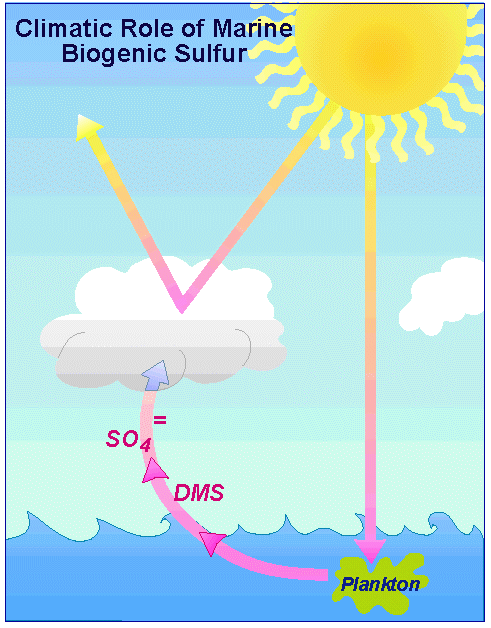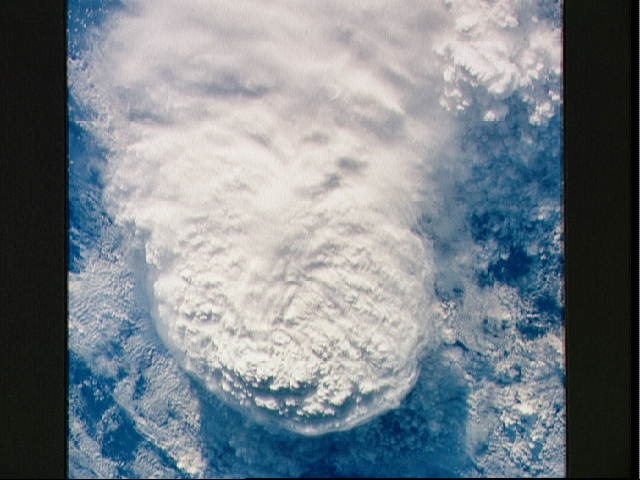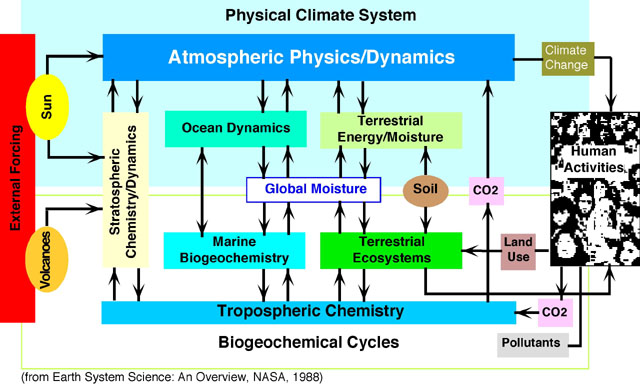
The Ocean and Climate
We are not merely inhabitants of a planet, adapting ourselves to it. Life has verily constructed the planet. It would not behave as it does, even in its deep interior, were it not for life. [Most of that life was in the ocean.]
(Oldroyd 1996: 297)
What is Climate
Traditionally, climate has been defined as the average weather: temperature, precipitation, cloudiness, and how these variables change throughout the year. Now, earth-system science leads to a much broader definition.
For many, the term "climate" refers to long-term weather statistics. However, more broadly and more accurately, the definition of climate is a system consisting of the atmosphere, hydrosphere, lithosphere, and biosphere. Physical, chemical, and biological processes are involved in interactions among the components of the climate system. Vegetation, soil moisture, and glaciers, for example, are as much a part of the climate system as are temperature and precipitation.
Pielke (2008).
The Ocean and Ocean Life Strongly Influenced Earth's Climate Over Billions of Years
Earth is totally different from what it would be if it had no ocean. The ocean, and life in the ocean, have "constructed the planet." The ocean is an important part of the Earth System, and it influences the transformation of energy and materials important to the climate system. On the most basic level, the ocean has shaped our atmosphere. Over millions of years, the concentration of gases in the atmosphere is determined by life. If life did not exist, especially life in the ocean, earth would be very different. On a deeper level, oceanic microbes irreversibly altered the geochemistry of earth and the biogeochemical cycles of H, C, N, O and S.
Please note, there is only one ocean with many named parts. The largest parts are the Atlantic, Indian, and Pacific Oceans. Earth would be much different if there were several different, disconnected oceans.
The evolution of photosynthesis remade the Archaean Earth. Before photosynthesis, the air and oceans were anoxic. Now the air is a biological construction, a fifth of which is free molecular oxygen, and the ocean can sustain animal life even in the depths. The evolution, first of anoxygenic [not producing oxygen] and then of oxygenic [producing oxygen] photosynthesis, sharply increased the productivity of the biosphere. Oxygenic photosynthesis sustains free oxygen in the atmosphere. In the oceans, the beneficiaries of the first photosynthetic prokaryotes [bacteria and archaea] today range from cyanobacterial and algal plankton to large kelp. Wearing plants as landsuits, from tiny mosses to giant redwoods, cyanobacteria as chloroplasts have occupied the land. The oxygen emitted has allowed the evolution of animal life, to browse the plants and, in turn, to respire the CO2 that sustains photosynthesis.
The management of the carbon cycle, by photosynthesis coupled with respiration, had profound consequences for the greenhouse setting of the surface temperature. Photosynthetic productivity controls the budgets of atmospheric carbon dioxide and, eventually, methane too. This sets global temperatures, weather patterns and may have even been a cause of the great glacial events, where much of the Earth’s surface froze over.
Bendall et al (2008).
- Carbon dioxide, the most common gas on Venus is rare in earth's atmosphere
because oceanic animals have used carbon dioxide to make vast layers
of carbonates in the form of limestone, dolomite, and marble. Without
life, our atmosphere would be similar to that of Venus. Most sedimentary
rocks were laid down in the ocean.
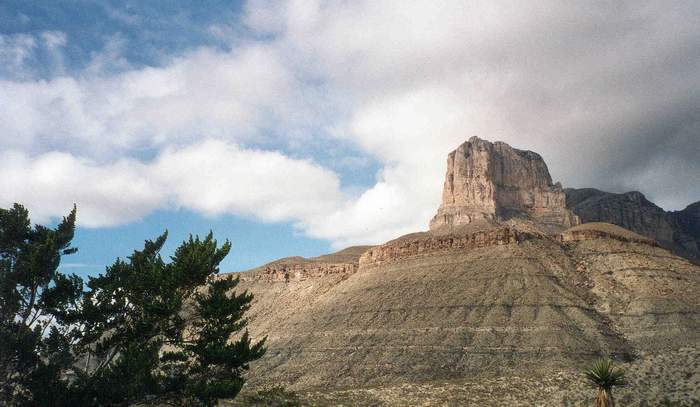
El Capitan, Capitan Reef, Guadalupe Mountains National Park, Texas. This is a coral reef is from the Permian. Photograph by Mark Eberle, November 1999.
From: Natural History of the Southwestern United States, a Fort Hayes State University course taught by Mark Eberle.
- Free oxygen O2 which is not found in the atmosphere of other planets, is produced by life. It is found in the atmosphere because of production by photosynthesis and the deposition of organic carbon on the the sea floor and the eventual inclusion of the organic carbon into continental rocks by plate tectonics acting over many millions of years (Falkowski and Godfrey, 2008). The organic carbon is stored in sedimentary rocks on continents in the form of oil shale, coal, oil, and natural gas.
- Oxygen in the atmosphere led to the formation of earth's stratospheric ozone layer which protects all life from solar ultraviolet radiation.
The Ocean Strongly Influence Earth's Present Climate
The ocean drives the atmospheric circulation by heating the atmosphere, mostly in the tropics.
- Most of the sunlight absorbed by earth is absorbed at the top of
the tropical ocean. The atmosphere does not absorb much sunlight.
It is
too transparent. Think of a cold, sunny, winter day at your school.
All day long, the sun shines on the outside, but the air stays
cold. But if you wear a black coat outside and stand out of the
wind, the sun will quickly warm up your coat. Sunlight passes
through the air and warms the surface of the ocean, just as it
warms the surface of your coat. Most of the ocean is a deep navy
blue, almost black. It absorbs 98% of the solar radiation when
the sun is high in the sky.
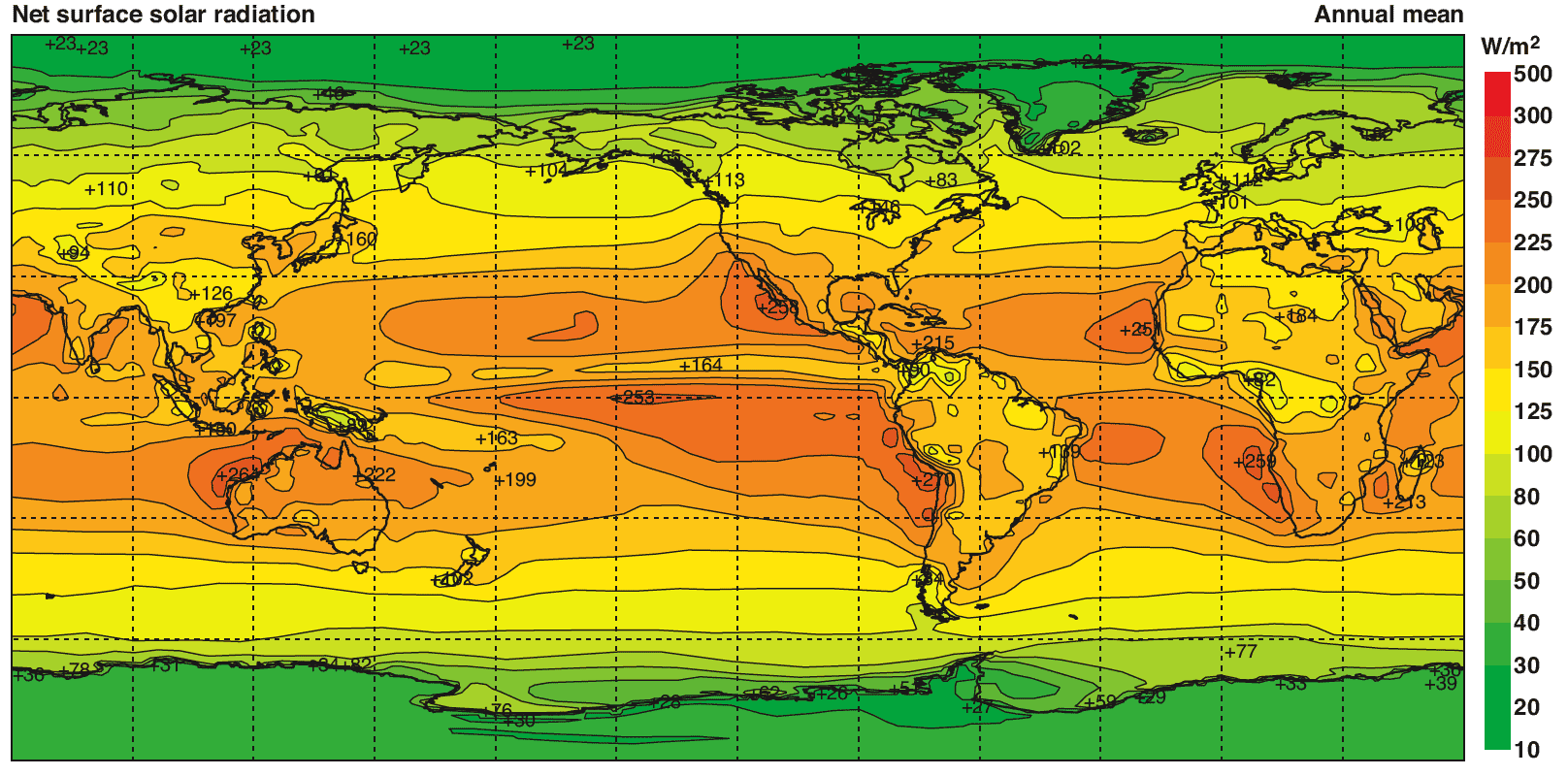
Heating of earth's surface by solar radiation, in W/m2, calculated from the ECMWF 40-year reanalysis of atmospheric data. Notice that most of the heat absorbed by earth goes into the tropical ocean.
From Kallberg et al 2005.
- The ocean loses heat by evaporation (the technical term is
latent heat release). Think of this as the ocean sweating. Trade
winds carry the evaporated water vapor to the Inter-Tropical
Convergence Zone where it condenses as rain. Condensation
releases the latent heat and warms the air. Warm air rises, further
drawing in warm wet air, releasing more heat. Large areas of the
tropical ocean get more than 3 m (115 inches) of rain each year
(8 mm/day in the figure below).
- So much heat is released by rain in the Inter-Tropical Convergence Zone that it drives much of the atmospheric circulation. This circulation is called the Hadley circulation.
- Heat released by rain in higher latitudes drives storms and winds.
- Heat released
by rain in hurricanes and thunderstorms drives these storms.
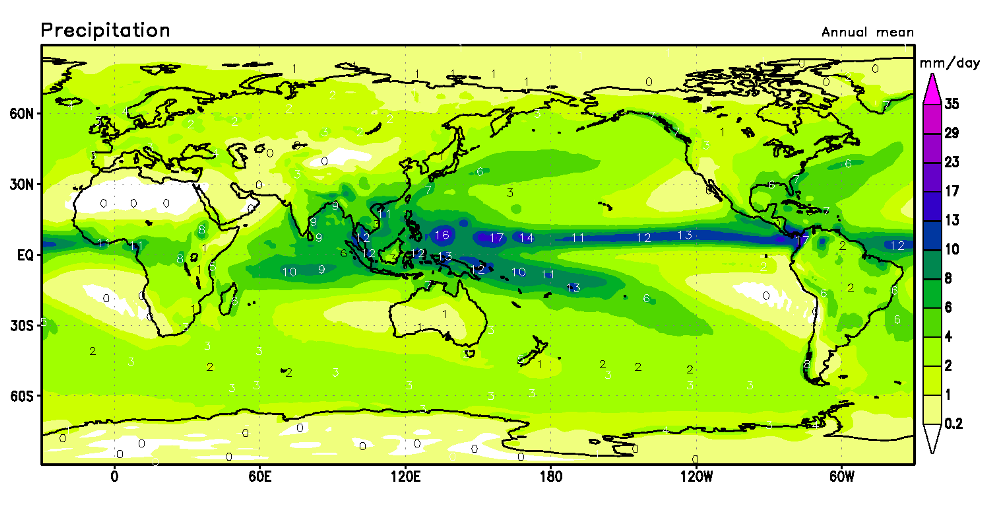
25-year average of rain rate.
From Japan Meteorological Agency, Japanese 25-year Reanalysis (JRA-25) Atlas.
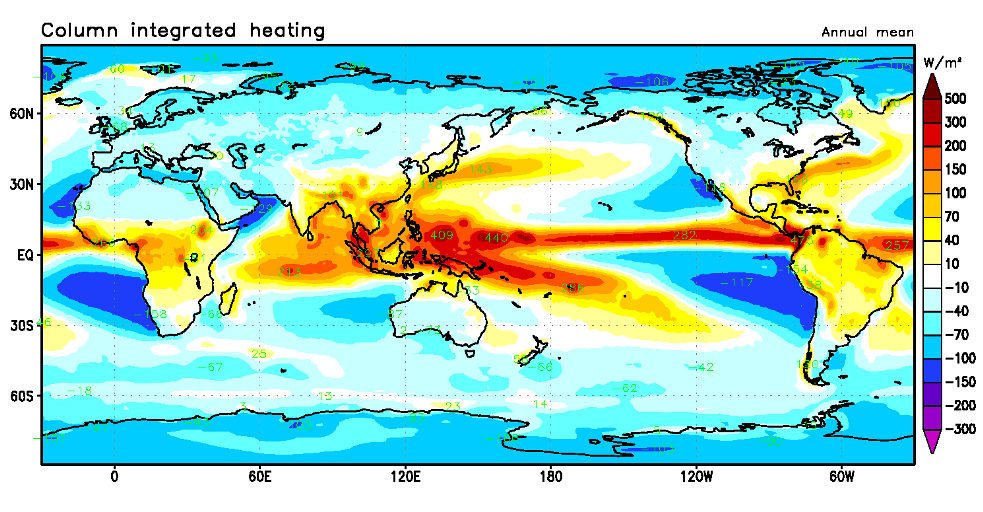
25-year average of heating of the atmosphere. Notice the high correlation with rain rate shown above. Rain and absorption of infrared radiation heats the atmosphere, mostly in the tropics. This heating drives the atmospheric circulation.
From Japan Meteorological Agency, Japanese 25-year Reanalysis (JRA-25) Atlas.
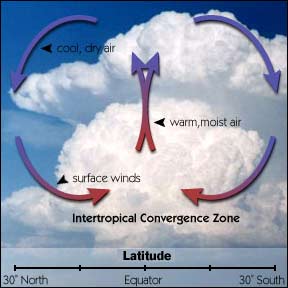
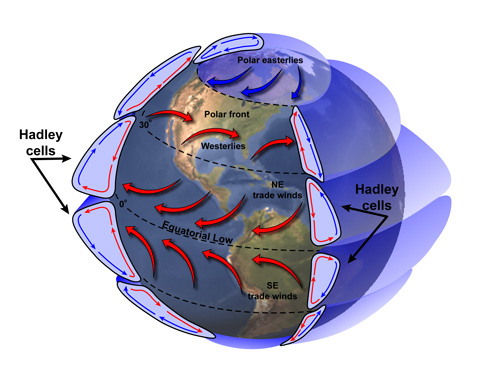
Left: Rain in the tropics warms the atmosphere and drives the Hadley circulation.
Image from The Why Files.
Right: The Hadley cells (circulation) are a major part of the climate system. Click on image for a zoom.
Image from NASA Earth Observatory, Fewer Clouds Found In Tropics.
- The ocean also loses heat by sending out infrared radiation (energy), mostly in the tropics. The infrared radiation is absorbed by water vapor in the tropical atmosphere, further heating the atmosphere.
- The winds drive ocean currents, and together they carry heat from the tropics to the polar regions. See The Climate System below.
The ocean dominates earth's hydrological cycle.
- All but 3% of earth's water is in the ocean.
- The ocean supplies almost all the water that falls on land. Watch moisture stream from the tropics into mid-latitudes where it falls as rain in this visualization for January and for August from the Visualization Group at the National Center for Atmospheric Research.
The ocean and ocean life control the amount of carbon dioxide in the atmosphere, and they dominate earth's carbon cycle.
Carbon dioxide is a greenhouse gas. By absorbing infrared radiation (energy) from the earth's surface, it helps keep the surface warm. The amount of carbon dioxide in the air is increasing, partly because we burn fossil fuels such as coal, natural gas, and oil. The increasing amounts of carbon dioxide are causing earth to slowly warm up. To understand the warming, we must understand how the ocean controls earth's carbon cycle.
- Most of the available carbon is in the ocean. The ocean holds 50 times more carbon than the atmosphere.
- About half of earth's
primary production, the conversion of water, carbon dioxide,
sunlight, and inorganic nutrients into oxygen and hydrocarbons,
occurs in the ocean. Primary producers in the ocean are the phytoplankton.
They also produce oxygen as a by product of this reaction.
- When the phytoplankton die and decay, or when they are eaten, the hydrocarbons are converted back to carbon dioxide, using up all the oxygen produced by the phytoplankton.
- But, sometimes phytoplankton and other life in the sea die and sink to the sea floor before they can decay. When they are buried in the sediments, they leave behind the oxygen produced by the phytoplankton. Over millions of years this produced the oxygen in the atmosphere. It also produced the oil, gas, and coal we now use to make electricity, heat our homes, and run our cars and trucks. We call this process the biological pump that takes carbon dioxide out of the air.
- Almost exactly half of the carbon dioxide put into the air by our burning of fossil fuels is absorbed by the ocean. Carbon dioxide dissolves in cold water near the Arctic and Antarctic. When the cold water sinks deep into the ocean in winter, it carries the carbon dioxide away from the atmosphere. Many years later, the water is gradually pulled closer to the sea surface by mixing in the ocean. When it gets to the surface in warm areas it releases the carbon dioxide back to the air. This process allows the ocean to store great quantities of carbon dioxide for many centuries. We call this the physical pump that takes carbon dioxide out of the air.
- The biosphere expands and contracts on a 450,000 year cycle in response to changes in insolation (incoming sunlight at different latitudes). The long period is due to long-term storage of carbon in the ocean and the dissolving of carbonate on the sea floor. Palike (2006).
Phytoplankton strongly influence cloud formation.
Clouds influence the reflection sunlight from earth, which influences earth's temperature (Meskhidze and Nenes (2006). The phytoplankton release great quantities of a sulfurous gas called dimethyl sulfide which changes the way clouds are formed in the atmosphere. First, sunlight causes chemical reactions that change the gas to sulfate aerosols (microscopic particles in the air). The tiny aerosol particles cause water vapor to condense to form cloud drops. Because about one-third of the sunlight reaching earth is reflected back to space by clouds, any process that influences cloudiness also influences the amount of sunlight that is absorbed by earth.
Phytoplankton in the ocean produce dimethyl sulfide (DMS) that is converted to sulfate aerosols (SO4), which influence the amount of sunlight reflected by clouds.
From Oceanic Dimethylsulfide (DMS) and Climate by the Atmospheric Chemistry Program at the National Oceanic and Atmospheric Administration's Pacific Marine Environmental Laboratory.
The ocean stores and transports heat.
Temperature in the atmosphere, even global changes in temperature are
slowed by the exchange of heat with the ocean. Thus, 18 times more
heat has been stored in the ocean since the mid 1950s due to global
warming than has been stored in the atmosphere. Most of the heat trapped
by greenhouse gases has gone into the ocean, not the atmosphere.
Earth's climate is the result of the uneven distribution of the temperature
at the surface. The difference in temperature between
the poles and the tropics eventually leads to winds and ocean currents
that carry heat heat from the tropics to the polar regions. The ocean
carries heat out of the tropics, and the winds carry heat to higher latitudes.
- The tropics are warm because they receive so much sunlight.
- The poles are cold because they receive much less sunlight, and because the
polar atmosphere is transparent to infrared radiation.
They radiate away much more heat
than they receive from the sun.
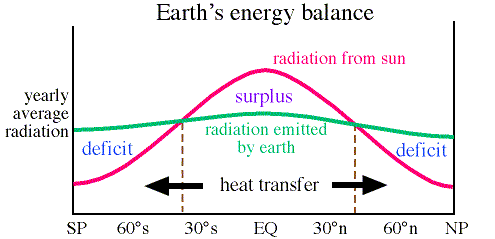
Zonal average of heat gained from the sun (red line) and lost to space by emitted infrared radiation (green line).
Image from Lyndon State College Survey of Meteorology course by Nolan Atkins.
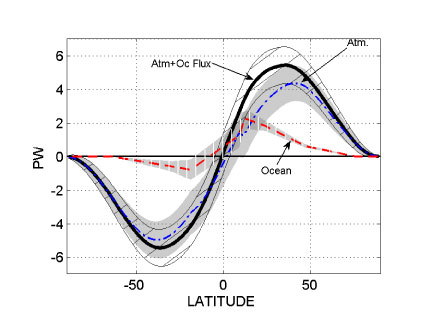
This plot shows the zonal average of heat transported by the atmosphere and the ocean in units of petawatts (PW = 1015 Watts) (solid black line), by the ocean (red dashed line), and by the atmosphere (blue dashed line), averaged along lines of constant latitude. The ocean is important for carrying heat out of the tropics, and the atmosphere is important at latitudes greater than 20°.
From Wunsch (2005). The Total Meridional Heat Flux and Its Oceanic and Atmospheric Partition. Journal of Climate, 18: 2374–2380.
- The transport of heat is influenced by many other parts of the
earth system.
- Continents interrupt or deflect winds and currents.
- Life on earth has changed the composition of the atmosphere, which has changed the way heat gets from earth's surface to space.
- Water vapor in the atmosphere also influences the way heat gets from earth's surface to space. Water vapor is the most important greenhouse gas.
- Water evaporated from the ocean carries heat into the atmosphere, and it warms the atmosphere when it condenses as precipitation. Most of the heating occurs in the tropical rain belts.
Variations in the ocean's circulation have been implicated in abrupt climate change during the last 400,000 years.
See Abrupt Climate Change web page.
The Ocean Influences Regional Climate
- The difference in temperature
between the land and the ocean drives monsoons. During the winter,
the center of a continent is much colder than the surrounding ocean.
This causes cold air to flow out of the continent. During the summer,
the center of continent is much hotter than the ocean. This draws
moist air into the continent bring much needed summer rains. Monsoon
winds are especially important for Asia and North America. Arizona,
and the American southwest get summer rains
From the North American monsoon.
Note: India gets rain during the Asian monsoon.

Arizona thunderstorm. Such storms in the American west are common in summer due to the North American monsoon. Click on the image for a zoom.
From the National Weather Service Forecast Office Flagstaff Arizona's article on the monsoon.
- Cities along coasts benefit from the sea
breeze. It too is due to
the difference in temperature between the land and the ocean. During
the night the land is cooler, and during the day it is warmer. The
contrast in temperature causes winds to blow toward the ocean
at night, and toward the land during the day.
Influence of Greenhouse Gases Especially Water Vapor
Let's look at how greenhouse gases influence the climate system, and how they might cause climate change. The ideas below come from George Philander's book, Our Affair With El Niño, chapter 7: Constructing a Model of Earth's Climate, page 105.
- Earth with no atmosphere
If earth had no atmosphere, if it had a land surface that reflected some sunlight like the real earth, and if it were in equilibrium with solar heating, the average surface temperature of earth would be -18°C (0°F), far colder than the average temperature of our earth, which is 15°C (59°F). Worse, the surface would cool down to around -160°C (-250°F) soon after the sun set because the surface would radiate heat to space very quickly, just as the moon's surface cools rapidly as soon as the sun sets on the moon.
- Earth with a static atmosphere and no ocean
If the earth had a static atmosphere with the same gases it has now, but with little water vapor and no ocean, the average surface temperature of earth would be 67°C (153°F). This is much warmer than our earth. The planet would be so hot because greenhouse gases in the atmosphere help keep heat near the surface, and because there is no convection, and no transport of heat by winds. Adding winds cools the planet a little, but not enough.
- Earth with an atmosphere and ocean
Earth has an atmosphere and ocean, and the average surface temperature is a comfortable 15°C (59°F). Water evaporates from the ocean and land, cooling the surface. Winds carry the water vapor to other latitudes, and sometimes high up into the air, where heat is released when the vapor condenses to water.
This very large thunderstorm was photographed by astronauts flying over the Indian Ocean, east of Madagascar (25.0N, 56.0E). The storm is about 65 nautical miles on a side and has a top that reaches into the stratosphere at 45,000 to 50,000 ft. and casts long shadows in the low sun. Such storms carry heat from the tropical seas high into the atmosphere, cooling the surface.
Image from Camex-4 Program, NASA Marshall Space Flight Center. Original from NASA Johnson Space Center.
Everything Is Connected
From this simple discussion of the climate system, we can conclude that we must understand how earth, with its atmosphere, greenhouse gases, ocean, life, winds, and currents all interact to produce our climate. The ocean is one big part of the earth system. The ocean, atmosphere,and land are connected through the climate system. Changes in one area cause changes everywhere else. Everything is connected, and everything influences everything else.
For example, rain heats the atmosphere. The warm air rises, creating wind. Wind drives ocean currents. Currents help determine where phytoplankton live. Phytoplankton help determine where clouds are formed. Clouds influences where the atmosphere is heated. Heating determines where the ocean evaporates, and the amount of evaporation.
There are many interacting parts in the earth system.
As a result of these connections:
- Earth has a surface temperature that is just right for life. Water vapor from the ocean is essential for setting the earth's temperature.
- The tropical ocean supplies almost all the water that falls on land.
- The ocean absorbs half of the carbon dioxide released by our burning of fossil fuels. This reduces global warming caused by carbon dioxide.
- So much heat is absorbed by the oceans, that the the warming of earth's surface by greenhouse gases is slowed down. 84% of the energy available to warm earth's surface has gone into the ocean during the 48 years from 1955 to 2003; 5% has gone into the land; 4% has gone into the atmosphere; and the remainder has gone into melting ice. (Levitus, 2005).
Conversion factors for temperature
- 0 degrees Celsius = 273.15 Kelvin
- Degrees Fahrenheit = 9/5 Celsius + 32
- So, zero degrees Celsius = 32 degrees Fahrenheit
References
Bendall, D. S., C. J. Howe, et al. (2008). Introduction. Photosynthetic and atmospheric evolution. Philosophical Transactions of the Royal Society B: Biological Sciences 363(1504): 2625-2628.
Oldroyd, D. R. (1996). Thinking About the Earth: A History of Ideas in Geology. Cambridge Massachusetts, Harvard University Press.
Falkowski, P. G. and L. V. Godfrey (2008). Electrons, life and the evolution of Earth's oxygen cycle. Philosophical Transactions of the Royal Society B: Biological Sciences 363 (1504): 2705–2716.
The biogeochemical cycles of H, C, N, O and S are coupled via biologically catalysed electron transfer (redox) reactions. The metabolic processes responsible for maintaining these cycles evolved over the first ca 2.3 Ga of Earth's history in prokaryotes and, through a sequence of events, led to the production of oxygen via the photobiologically catalysed oxidation of water. However, geochemical evidence suggests that there was a delay of several hundred million years before oxygen accumulated in Earth's atmosphere related to changes in the burial efficiency of organic matter and fundamental alterations in the nitrogen cycle. In the latter case, the presence of free molecular oxygen allowed ammonium to be oxidized to nitrate and subsequently denitrified. The interaction between the oxygen and nitrogen cycles in particular led to a negative feedback, in which increased production of oxygen led to decreased fixed inorganic nitrogen in the oceans. This feedback, which is supported by isotopic analyses of fixed nitrogen in sedimentary rocks from the Late Archaean, continues to the present. However, once sufficient oxygen accumulated in Earth's atmosphere to allow nitrification to out-compete denitrification, a new stable electron 'market' emerged in which oxygenic photosynthesis and aerobic respiration ultimately spread via endosymbiotic events and massive lateral gene transfer to eukaryotic host cells, allowing the evolution of complex (i.e. animal) life forms. The resulting network of electron transfers led a gas composition of Earth's atmosphere that is far from thermodynamic equilibrium (i.e. it is an emergent property), yet is relatively stable on geological time scales. The early coevolution of the C, N and O cycles, and the resulting non-equilibrium gaseous by-products can be used as a guide to search for the presence of life on terrestrial planets outside of our Solar System.
Meskhidze, N. and A. Nenes (2006). Phytoplankton and Cloudiness in the Southern Ocean. Science 314 (5804): 1419–1423.
Kallberg P., P. Berrisford, et al. (2005). ERA-40 Atlas. European Centre for Medium Range Weather Forecasts.
Levitus, S., J. Antonov, et al. (2005). Warming of the world ocean. Geophysical Research Letters 32 (1).
Palike, H., R. D. Norris, et al. (2006). The Heartbeat of the Oligocene Climate System. Science 314 (5807): 1894-1898.
Philander, S. G. (2004). Our Affair With El Niño, Princeton University Press.
Pielke Sr, R. A. (2008). A broader view of the role of humans in the climate system. Physics Today 61 (11): 54–55.
Wunsch (2005). The Total Meridional Heat Flux and Its Oceanic and Atmospheric Partition. Journal of Climate, 18: 2374–2380.
Revised on: 29 May, 2017

